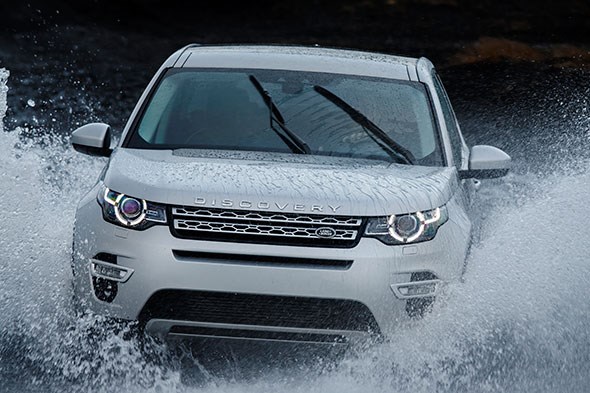► Full test of new Disco Sport
► It’s the Freelander replacement
► We drive latest 2.2 D
The new Land Rover Discovery Sport fills the hole left by the departing Freelander. Sort of. Land Rover is adamant that this is an incremental new model, but its price, size and positioning suggests it is the entry-level Landie for now. Until the new Defender replacement arrives in 2016, at least.
You’ll enjoy seven seats in the Discovery Sport, though, hinting at its Discovery-ish practicality imbued from day one on a clean sheet of paper. While Range Rovers will add luxury and sparkle and – let’s be honest – a degree of bling to proceedings, humble Land Rovers will stick a healthy dollop of practicality and family-friendliness into the equation in future.
So take note of 2015’s new Disco Sport. It tells us a lot about where Land Rover is heading. Read on for our first full Discovery Sport review.
First drive of the Land Rover Discovery Sport 2.2 SD4
We test a mid-ranking Sport rolling on 19in wheels; it looks good on first acquaintance, with a clear bloodline to cars such as the Evoque, which has been so successful for the coffers of Jaguar Land Rover (JLR) in recent years.
The two are related under the skin, too. The Sport uses Evoque running gear, with the same engine, transmission and Haldex centre coupling, controlled by the same Terrain Response system. Later in 2015 new inhouse Ingenium engines will arrive, but for now we test the single motor available, the familiar PSA-Ford-JLR turbodiesel.
The 187bhp 2.2-litre diesel engine and nine-speed automatic gearbox are strong, mostly smooth and slick, the car riding well on the Icelandic test routes of our first drive. We’ve yet to drive the car in the UK and will update this Discovery Sport review with further updates in due course.
We like the size, too; driving many full-size Land Rovers can feel a chore in modern Britain – a Disco or Range Rover is too big for many roads and daily drives. While the new Discovery Sport is around 9cm longer than the outgoing Freelander 2, it’s also a few millimetres narrower and lower, and that helps it feel nimble and compact on the road.
A Chelsea tractor, it is not.
Inside the cabin of the Discovery Sport
The interior of the Disco Sport is supposed to be a family-friendly retreat, and this is our first chance to assess Land Rover’s success in the cabin design outside the flashbulbed environs of a motor show.
The dashboard will scare nobody used to modern LR cockpits: it’s upright and simple with a pleasing Tonka Toy simplicity to the controls. There’s a strong linearity to the design – the central touchscreen forming a horizontal band across the dash and instruments, while most secondary controls are in the upright centre console, where large, plain buttons predominate.
It’s only when you’re sitting in the Discovery Sport that you appreciate the quality of the thing. This is a very well built car, one of the most beautifully finished cabins we’ve seen in this sector in ages. The materials are well chosen and pleasing to touch; the rotary dials operate with deft precision; the plump leather upholstery sitting cheek-by-jowl with chunky rubber mats in our test car in Iceland.
It’s nice to be reminded that you could hose them down with a farmyard jet wash, even if most owners won’t. Isn’t that at the heart of the appeal of a Land Rover?
Is it a proper family car?
Inside the Discovery Sport is roomy, but it’s also intimate, like you’re driving a normal family car rather than a barge.
The back seats of the Discovery Sport slide on a rail, so you can push the middle bench back for proper limo-style legroom, and there’s the third row of course, though on this trip seat #6 and #7 are redundant and trapped under a rubber mat. They’re pretty small and best left to young children.
Is the Discovery Sport a proper Land Rover?
You bet. We’ve taken our Range Rover Evoque off-road in a previous long-term test (see more here) and you can check out an extreme off-roading tale in the new Discovery Sport in the next issue of CAR magazine, the January 2015 edition.

Suffice to say the axle articulation and four-wheel drive hardware standard on all Disco Sports at launch (FWD models to follow) will get you to more places than a rival Volvo XC60 or BMW X3 ever would. Unlike the newer Range Rovers, there is no ‘Auto’ setting for the Terrain Response.
With aluminium wings, bonnet, roof and tailgate, it’s 700kg lighter than the standard Disco 4, which helps keep momentum up on soft and boggy ground.
Verdict
It’s hard to envisage any reasons why the Land Rover Discovery Sport won’t sell well. Yes, styling may be slightly generic for some and some users may still balk at the launch engine’s mid-ranking CO2 (166g/km) and economy (44.8mpg) claims beaten by the Germans. But on first impressions the Disco Sport is an incredibly well rounded package.